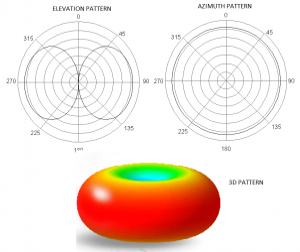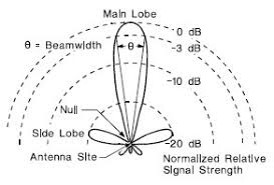Antenna
The sole component which changed the world of communication technology from wired to wireless is antenna. That is because antennas convert the electromagnetic fields to current in antenna (Reception) and current flowing through them into the electromagnetic fields (Transmission). These electromagnetic waves associated with antenna can traverse freely through air giving it “wireless” capabilities.
While selecting an antenna one would like to know about the characteristics of an antenna. We will now see what these characteristics are and how they affect the working and usage of antennas.
Contents
Characteristics of an Antenna
Field Regions
There are three types of field regions:
- Reactive near field: It is in immediate vicinity of antenna. The E-fields and H-fields here are 90° out of phase.
- Radiative near field: Here the radiation pattern (radiated power vs direction) varies considerably with distance (away from antenna).
- Far field: Here the radiation pattern is constant with respect to distance from antenna. Any antenna placed in far field of another antenna is not affected by its radiations.
Radiation Pattern
The graphical representation of power distributed as a function of direction in the far field of an antenna is it’s radiation pattern. Let's say we place an antenna at the centre of an imaginary sphere. Now we take a device which can measure the energy of radiation at a place and take readings using it at all the points on the sphere. The decibel plot of power received as a function of elevation or azimuth is radiation plot. More commonly, a polar plot is plotted with radius describing normalised radiation power to draw the radiation pattern. The function of power with azimuth and elevation is known as radiation function.
These plots are very helpful as they give insight to many properties of antennas such as gain, directivity and also assist in visualization of power distribution in the real scenario.
Example: The radiation pattern for dipole antenna is as follows.
Frequency
An antenna is always designed for a specific frequency. Once the frequency is set, the wavelength of antenna is set too and all the dimensions of antenna are specified in terms of its wavelength.
Directivity
As the name suggests, directivity is the measure of how directed the antenna radiation pattern is. That is how much an antenna transmits in a particular direction as opposed to transmitting uniformly in all directions. The radiation pattern can be depicted as a function of azimuth angle and elevation angle. The ratio of max power in radiation pattern function to the average power of radiation gives us the directivity of any antenna. Mathematically, if F(Θ,Φ) denotes the radiation function, directivity can be described by:
Based upon directivity, antennas can be divided in three groups:
- Isotropic: An isotropic antenna is an ideal antenna which radiates uniform power in all directions. Hence it's directivity would be 1(0 dB).
- Omnidirectional: Omnidirectional antenna radiates uniform power in a single plane and its power diminishes as we go away from the plane. Hence it's radiation pattern resembles a “doughnut”.
- Directional: Directional antennas can radiate greater amount of power in a specific direction compared to any other direction. Their directivities are very high. They have complicated (and often interesting) radiation patterns.
| Antenna Type | Typical Directivity | Typical Directivity (dB) |
| Short Dipole | 1.5 | 1.76 |
| Half-wave dipole | 1.64 | 2.15 |
| Patch (Microstrip) | 3.2-6.3 | 5-8 |
| Horn | 10-100 | 10-20 |
| Dish | 10-10000 | 10-40 |
As is evident, directivity can vary greatly with type of antenna. Hence it's important to understand and know directivity before selecting antenna for your application. Like, if you are going to receive/transmit signal from/to any direction, it is better to use antenna with low directivity. Similarly in an application where the direction of signal is fixed, highly directed antennas work way better.
Half Power Beamwidth
As we have directional antennas, one obvious question we can get for what angle we can get good radiation power? Although the answer to this question also depends on receiving setup, it is generally defined as the point where the power output drops to half its maximum value. When converted to dB it amounts to approx 3 dB loss, hence it is also called 3 dB point. In one plane, there are going to be two such points. The angular separation between the two points is half power beamwidth.
Antenna Efficiency
Antenna efficiency is basically ratio of power radiated from the antenna to the power delivered to antenna. In short, it denotes the losses due to antenna. The losses could be attributed to three major factors:
- Conduction losses: These are losses due to finite conductivity of elements of antenna
- Dielectric losses: The electric fields induce current in the nearby dielectrics reducing the energy carried by fields. These are dielectric losses
- Impedance mismatch: Some part of power delivered to antenna by transmitter is reflected back due to mismatch in impedance of antenna driving circuit(transmitter) and antenna and hence results in loss of power. We will talk about impedance mismatch and matching later.
Voltage Standing Wave Ratio (VSWR)
Impedance matching, which is described in above section, is quantified using the VSWR. It basically describes the power reflected back from the antenna-transmitter junction. More reflected power signifies greater impedance mismatch loss. VSWR is related to reflection coefficient (more commonly known as s11, and represents how much power is reflected back from antenna) by the following formula
Lower the VSWR, better is the antenna impedance matched. VSWR can be easily found out using Vector Network Analyser (VNA).



